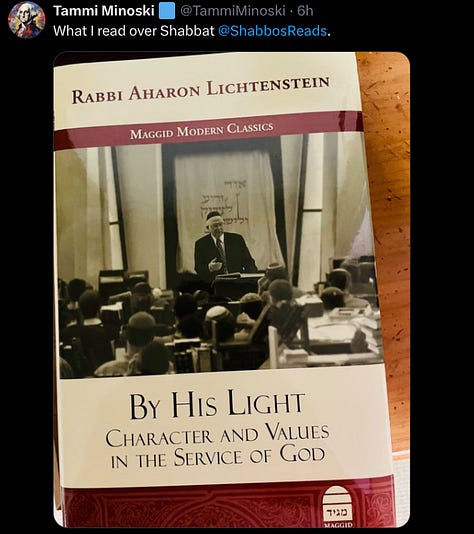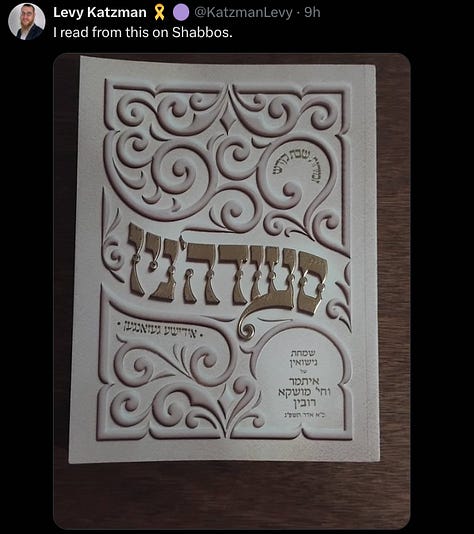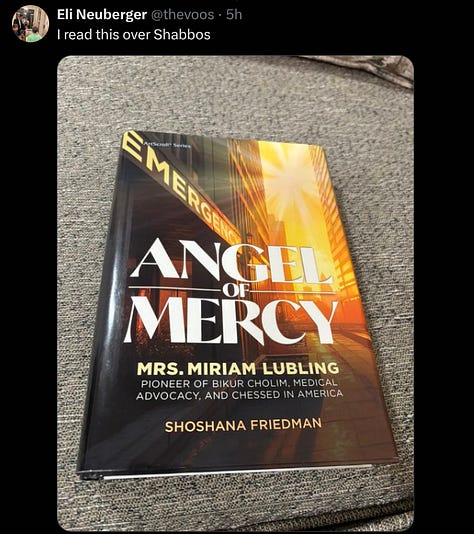Three Books that Changed my Understanding of Jewish History
Tamar Ron Marvin on the books that shaped her
Hello friends! This week’s newsletter features a guest post by Dr. Tamar Ron Marvin, a scholar, educator, and writer of Jewish history. Tamar’s Substack, Stories from Jewish History, and website are incredible resources to study Jewish history in an interesting and accessible way. Today, she brings us her top three books that have changed the way she views Jewish history. It’s a fascinating insight into the world of intellectual history (of which I, personally, am not such an expert). Over to Tamar!
When my family made aliyah last year, I found myself needing to pare down my personal library to the most essential volumes—no small feat for an inveterate reader, beit midrash dweller, and academic. I found myself placing three types of books in the “put on the lift” pile: first, seforim, most (though not quite all) of which made the cut; then, trusty reference books which I use regularly; and finally, my treasured coterie of what I call “books to think with”—those whose ideas profoundly influenced me as a scholar and continue to shape me.
The books I’d like to talk about today fall in this last category. They are “idea books” whose influence is not, however, confined to their theses but also includes their methodology. In other words, they impacted both how I go about conducting and presenting research, as well as the ideas I offer as I interpret that research. This means that a book like my literally falling-apart copy of Colette Sirat’s A History of Jewish Philosophy in the Middle Ages, which I use often for reference, is not in the running for the top three books that changed my understanding of Jewish history. It also means that the many seminal articles (but not whole books) that lit my path to becoming a scholar are not in contention here. I have omitted, too, idea books of a broader nature, such as Walter Ong’s fascinating Orality and Literacy, which has much influenced my thinking.
Bernard Septimus, a student of Isidore Twersky at Harvard, is the guiding light of how I compose evidence-based historical narrative. His Hispano-Jewish Culture in Transition tells the story of a pivotal moment in Jewish history by focusing on Ramah, R. Meir ha-Levi Abulafia, who lived from around 1170 to 1244. The choice of Ramah is significant. Best known for a small work on the Masoretic text of Tanach, Masoret Seyag la-Torah (upon which Menachem ha-Meiri’s Kiryat Sefer is based), Ramah also penned a massive commentary on Shas, most of which remains in manuscript, having been eclipsed by the method introduced soon after Ramah’s time by Ramban. Ramah, in other words, did not make it into the upper echelons of late Sefardi Rishonim with Ramban, Ritva, or Rashba. But while only Ramban has been the subject of monographs, Ritva and Rashba have not yet been so treated, neither in Hebrew nor in English. Ramah, however, in Septimus’ hands, becomes a prism for the complexities of his time. This taught me to look carefully at understudied figures and works for what they can tell us about the larger story of Jewish history. More than that, Septimus’ mastery in marshalling a broad array of Hebrew sources to tell that story showed me how to craft narrative history that rests on disparate sources.
I am, myself, an intellectual historian, so the next title, with its socioeconomic focus and use of archival sources, pertains less directly to my own work. In addition, I am not convinced by all of its claims, many of which have been outlined in a critical (though not dismissive) review by Gavin I. Langmuir in the Jewish Quarterly Review 88 (1997). Nevertheless, David Nirenberg’s Communities of Violence left an indelible mark on my way of doing history in its method and its interpretive originality. Communities of Violence makes a set of complex and intertwining arguments. It seeks to dispute the tendency of medievalists to locate roots of modern antisemitic violence in the Middle Ages, arguing instead that medieval violence occurred in particular, localized contexts and bore wholly different meanings to its perpetrators than did, say, Nazi ideology. He also eschews psychologized readings of medieval violence, especially those that impute irrational motives to medieval people. Nirenberg argues instead that violence against minorities in the Middle Ages—he examines the cases of Jews, Muslims, and lepers in Christian Spain and France in the first half of the fourteenth century—was impelled by political and economic motivations and also paradoxically enabled a certain degree of tolerance in intolerant times.
Nirenberg’s thesis must be read, I think, with his important book Anti-Judaism: The Western Tradition, which demonstrates that antisemitism is not only endemic to the West, it is also a mode of meaning-making constitutive of Western culture. In other words, Nirenberg is hardly disputing the sadly ubiquitous nature of medieval violence towards minorities; in fact, his research supports it. Even where I disagree, I am taken by Nirenberg’s ability to create complex arguments that neither downplay nor overstate medieval violence, and insist on seeing it in its particularities and contexts. In addition, though he primarily relies upon archival records to build his argument, Nirenberg also weaves in chronicles and other texts, both Christian and Jewish. The richness of his source material and the skill with which he uses it to reconstruct and narrate historical events are inspiring.
Last but certainly not least is Amos Funkenstein’s Perceptions of Jewish History. Like Communities of Violence, it pushes back against scholarship with which I am wont to agree. In opening up this space, Funkenstein demonstrates that as striking and seemingly self-evident a thesis as that presented in Yosef Yerushalmi’s Zakhor—that the imperative to remember in Judaism did not translate into the writing of Jewish history in the many centuries before the modern era—is not the only possible take, nor one that holds water. Funkenstein showed me that I myself had intuited valid criticisms of Yerushalmi’s presentation, and that they could be marshalled into a more complex, and in my mind more correct, argument (augmented, it should be noted, by Robert Bonfil’s incisive article, “How Golden was the ‘Golden Age’ of Jewish Historiography?”). Namely, Funkenstein suggests that just because the recording of Jewish historical consciousness in premodernity was unlike that of modern academic history does not mean that Jewish historical writing did not exist. He insists, that is, on the idea that post-Enlightenment historiography does not get to determine the seriousness of Jewish collective memory through the ages, and demonstrates this through exacting diachronic study of Jewish meaning-making through the interpretation of history.
I do not conduct my research, nor do I write, quite like Funkenstein, Nirenberg, or Septimus. Funkenstein is a big-ideas, diachronic thinker; Nirenberg is an exacting master of archival detail; and Septimus was more interested in the context of ideas than in their content, that is, in their worlds over their internal meaning. I tend to be more textual, reading Hebrew texts closely and exploring their impact on subsequent Jewish thought and how they might bring meaning to our lives today. Yet elements of all three scholars are not just evident in my work, they are through-lines. As I introduce a subject or conclude an argument, I am in Funkenstein’s territory; when I suggest a thesis that builds upon but changes a given view, I am in Nirenberg’s; and when I weave together sources to portray a moment in time, I am in Septimus’.
What did you read over Shabbos?
A selection of shared Shabbos reads


















